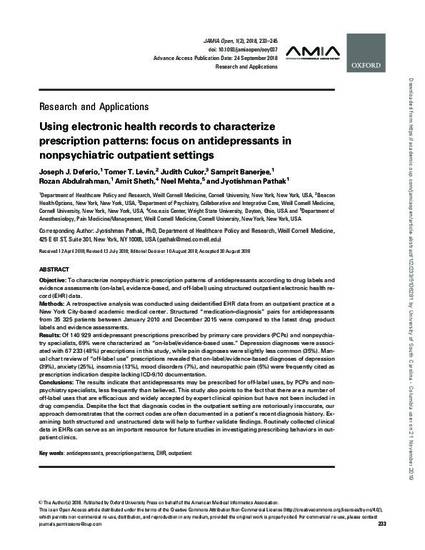
Objective To characterize nonpsychiatric prescription patterns of antidepressants according to drug labels and evidence assessments (on-label, evidence-based, and off-label) using structured outpatient electronic health record (EHR) data.
Methods A retrospective analysis was conducted using deidentified EHR data from an outpatient practice at a New York City-based academic medical center. Structured “medication–diagnosis” pairs for antidepressants from 35 325 patients between January 2010 and December 2015 were compared to the latest drug product labels and evidence assessments.
Results Of 140 929 antidepressant prescriptions prescribed by primary care providers (PCPs) and nonpsychiatry specialists, 69% were characterized as “on-label/evidence-based uses.” Depression diagnoses were associated with 67 233 (48%) prescriptions in this study, while pain diagnoses were slightly less common (35%). Manual chart review of “off-label use” prescriptions revealed that on-label/evidence-based diagnoses of depression (39%), anxiety (25%), insomnia (13%), mood disorders (7%), and neuropathic pain (5%) were frequently cited as prescription indication despite lacking ICD-9/10 documentation.
Conclusions The results indicate that antidepressants may be prescribed for off-label uses, by PCPs and nonpsychiatry specialists, less frequently than believed. This study also points to the fact that there are a number of off-label uses that are efficacious and widely accepted by expert clinical opinion but have not been included in drug compendia. Despite the fact that diagnosis codes in the outpatient setting are notoriously inaccurate, our approach demonstrates that the correct codes are often documented in a patient’s recent diagnosis history. Examining both structured and unstructured data will help to further validate findings. Routinely collected clinical data in EHRs can serve as an important resource for future studies in investigating prescribing behaviors in outpatient clinics.
Available at: http://works.bepress.com/amit_sheth/614/
